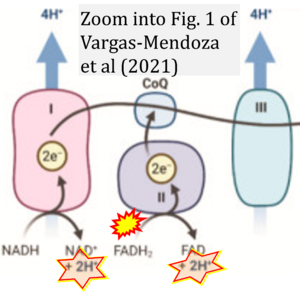Vargas-Mendoza 2021 Life (Basel)
| Vargas-Mendoza N, Angeles-Valencia M, Morales-González Á, Madrigal-Santillán EO, Morales-Martínez M, Madrigal-Bujaidar E, Álvarez-González I, Gutiérrez-Salinas J, Esquivel-Chirino C, Chamorro-Cevallos G, Cristóbal-Luna JM, Morales-González JA (2021) Oxidative stress, mitochondrial function and adaptation to exercise: new perspectives in nutrition. Life (Basel) 11:1269. https://doi.org/10.3390/life11111269 |
Vargas-Mendoza N, Angeles-Valencia M, Morales-Gonzalez A, Madrigal-Santillan EO, Morales-Martinez M, Madrigal-Bujaidar E, Alvarez-Gonzalez I, Gutierrez-Salinas J, Esquivel-Chirino C, Chamorro-Cevallos G, Cristobal-Luna JM, Morales-Gonzalez JA (2021) Life (Basel)
Abstract: Cells have the ability to adapt to stressful environments as a part of their evolution. Physical exercise induces an increase of a demand for energy that must be met by mitochondria as the main (ATP) provider. However, this process leads to the increase of free radicals and the so-called reactive oxygen species (ROS), which are necessary for the maintenance of cell signaling and homeostasis. In addition, mitochondrial biogenesis is influenced by exercise in continuous crosstalk between the mitochondria and the nuclear genome. Excessive workloads may induce severe mitochondrial stress, resulting in oxidative damage. In this regard, the objective of this work was to provide a general overview of the molecular mechanisms involved in mitochondrial adaptation during exercise and to understand if some nutrients such as antioxidants may be implicated in blunt adaptation and/or an impact on the performance of exercise by different means.
• Bioblast editor: Gnaiger E
Correction: FADH2 and Complex II
- FADH2 is shown as the substrate feeding electrons into Complex II (CII). This is wrong and requires correction - for details see Gnaiger (2024).
- Gnaiger E (2024) Complex II ambiguities ― FADH2 in the electron transfer system. J Biol Chem 300:105470. https://doi.org/10.1016/j.jbc.2023.105470 - »Bioblast link«
Hydrogen ion ambiguities in the electron transfer system
Communicated by Gnaiger E (2023-10-08) last update 2023-11-10
- Electron (e-) transfer linked to hydrogen ion (hydron; H+) transfer is a fundamental concept in the field of bioenergetics, critical for understanding redox-coupled energy transformations.
- However, the current literature contains inconsistencies regarding H+ formation on the negative side of bioenergetic membranes, such as the matrix side of the mitochondrial inner membrane, when NADH is oxidized during oxidative phosphorylation (OXPHOS). Ambiguities arise when examining the oxidation of NADH by respiratory Complex I or succinate by Complex II.
- Oxidation of NADH or succinate involves a two-electron transfer of 2{H++e-} to FMN or FAD, respectively. Figures indicating a single electron e- transferred from NADH or succinate lack accuracy.
- The oxidized NAD+ is distinguished from NAD indicating nicotinamide adenine dinucleotide independent of oxidation state.
- NADH + H+ → NAD+ +2{H++e-} is the oxidation half-reaction in this H+-linked electron transfer represented as 2{H++e-} (Gnaiger 2023). Putative H+ formation shown as NADH → NAD+ + H+ conflicts with chemiosmotic coupling stoichiometries between H+ translocation across the coupling membrane and electron transfer to oxygen. Ensuring clarity in this complex field is imperative to tackle the apparent ambiguity crisis and prevent confusion, particularly in light of the increasing number of interdisciplinary publications on bioenergetics concerning diagnostic and clinical applications of OXPHOS analysis.
Labels: MiParea: Exercise physiology;nutrition;life style




